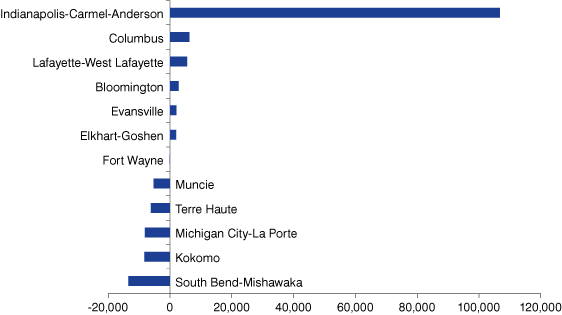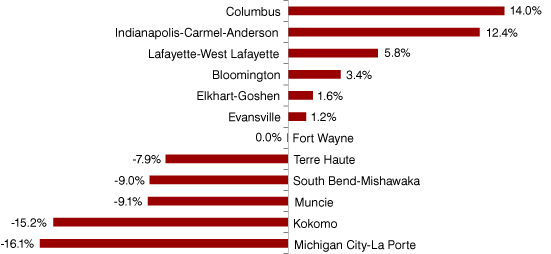Job Growth Uneven across Indiana
The accumulating news of employment growth in the nation and Indiana are promising, even if the speed of this growth is still under debate. However, often overlooked in the tabulation of aggregate numbers is the composition and location of these jobs. This article assesses the latter point in determining the location of job growth in Indiana.
Taking the U.S. Bureau of Labor Statistics (BLS) non-seasonally adjusted Current Employment Statistics (CES) employment data for metropolitan statistical areas (MSA), it is possible to track metro-level employment growth from October 2000 to October 2014.
In examining the MSA data for the 12 Indiana-based areas, one can see that over the course of 14 years, employment grew by 84,114, an increase of 4.2 percent (see Table 1). The 2013 Census population estimates for these MSAs was 4,146,968, resulting in an employment growth to population ratio of 2 percent.
Table 1: Employment Growth Comparison
| MSA | October 2000 | October 2014 | Change since 2000 | Percent Change since 2000 | 2013 Population Estimate | Employment Growth to Population Ratio |
|---|---|---|---|---|---|---|
| Indianapolis-Carmel-Anderson | 861,100 | 967,900 | 106,800 | 12.4% | 1,953,961 | 5.5% |
| Columbus | 45,000 | 51,300 | 6,300 | 14.0% | 79,587 | 7.9% |
| Lafayette-West Lafayette | 96,400 | 102,000 | 5,600 | 5.8% | 209,027 | 2.7% |
| Bloomington | 82,200 | 85,000 | 2,800 | 3.4% | 163,089 | 1.7% |
| Evansville, IN-KY |
178,800 | 180,900 | 2,100 | 1.2% | 314,280 | 0.7% |
| Elkhart-Goshen | 124,800 | 126,800 | 2,000 | 1.6% | 200,563 | 1.0% |
| Fort Wayne | 220,200 | 220,100 | -100 | 0.0% | 424,122 | 0.0% |
| Muncie | 58,400 | 53,100 | -5,300 | -9.1% | 117,484 | -4.5% |
| Terre Haute | 78,200 | 72,000 | -6,200 | -7.9% | 172,195 | -3.6% |
| Michigan City-La Porte | 50,400 | 42,300 | -8,100 | -16.1% | 111,281 | -7.3% |
| Kokomo | 54,600 | 46,300 | -8,300 | -15.2% | 82,760 | -10.0% |
| South Bend-Mishawaka, IN-MI |
150,500 | 137,000 | -13,500 | -9.0% | 318,619 | -4.2% |
| Total | 2,002,600 | 2,086,714 | 84,114 | 4.2% | 4,146,968 | 2.0% |
| Total Minus Indianapolis-Carmel-Anderson | 1,141,500 | 1,118,814 | -22,686 | -2.0% | 2,193,007 | -1.0% |
Note: Gary is omitted because it is part of the Chicago MSA. The South Bend-Mishawaka MSA includes Cass County in Michigan, and the Evansville MSA includes Henderson County in Kentucky.
Source: U.S. Bureau of Labor Statistics non-seasonally adjusted CES data and U.S. Census Bureau population estimates
While the employment gains are certainly welcome, the distribution of these gains should also be examined. By a wide margin, the aggregate gains are accumulated in the Indianapolis-Carmel-Anderson MSA (see Figure 1). Without the Indianapolis area, the other 11 MSAs in aggregate actually experienced negative employment growth over 14 years (-22,686 jobs or -2 percent).
Figure 1: MSA Employment Growth, 2000 to 2014

Note: The South Bend-Mishawaka MSA includes Cass County in Michigan, and the Evansville MSA includes Henderson County in Kentucky.
Source: U.S. Bureau of Labor Statistics October data
Since the Indianapolis-Carmel-Anderson MSA is also the largest in terms of population, it will likely have the largest employment growth in numeric terms. It is therefore useful to examine the growth both in terms of percentage and the ratio of employment growth to population.
In terms of percentage growth, only the Columbus MSA had a higher growth rate than the Indianapolis area (see Figure 2). This had little impact on the aggregate numbers since the Columbus MSA is the smallest MSA of those examined.
Figure 2: Percent Change in MSA Employment, 2000 to 2014

Note: The South Bend-Mishawaka MSA includes Cass County in Michigan, and the Evansville MSA includes Henderson County in Kentucky.
Source: U.S. Bureau of Labor Statistics October data
In terms of employment growth to population, the Columbus MSA is again higher than the Indianapolis-Carmel-Anderson MSA. However, even with its large size, the Indianapolis-Carmel MSA generates more job growth relative to its population when compared to the other MSAs.
While job growth in the state is welcome, efforts to extend this growth uniformly throughout the state appear justified as distribution inequality is evident in the data.
